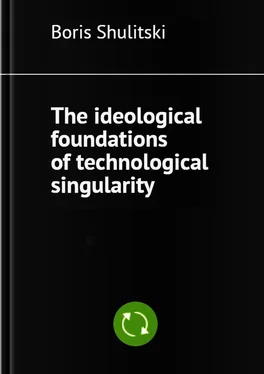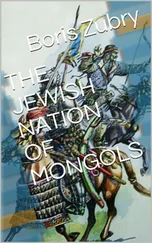Boris Shulitski - The ideological foundations of technological singularity
Здесь есть возможность читать онлайн «Boris Shulitski - The ideological foundations of technological singularity» — ознакомительный отрывок электронной книги совершенно бесплатно, а после прочтения отрывка купить полную версию. В некоторых случаях можно слушать аудио, скачать через торрент в формате fb2 и присутствует краткое содержание. ISBN: , Жанр: Прочая околокомпьтерная литература, Философия, Прочая научная литература, на английском языке. Описание произведения, (предисловие) а так же отзывы посетителей доступны на портале библиотеки ЛибКат.
- Название:The ideological foundations of technological singularity
- Автор:
- Жанр:
- Год:неизвестен
- ISBN:9785449633286
- Рейтинг книги:3 / 5. Голосов: 1
-
Избранное:Добавить в избранное
- Отзывы:
-
Ваша оценка:
- 60
- 1
- 2
- 3
- 4
- 5
The ideological foundations of technological singularity: краткое содержание, описание и аннотация
Предлагаем к чтению аннотацию, описание, краткое содержание или предисловие (зависит от того, что написал сам автор книги «The ideological foundations of technological singularity»). Если вы не нашли необходимую информацию о книге — напишите в комментариях, мы постараемся отыскать её.
The ideological foundations of technological singularity — читать онлайн ознакомительный отрывок
Ниже представлен текст книги, разбитый по страницам. Система сохранения места последней прочитанной страницы, позволяет с удобством читать онлайн бесплатно книгу «The ideological foundations of technological singularity», без необходимости каждый раз заново искать на чём Вы остановились. Поставьте закладку, и сможете в любой момент перейти на страницу, на которой закончили чтение.
Интервал:
Закладка:
In chapter V , the fundamentally new innovative technology of information-controlled self-assembly of nanostructured materials is seen on the horizon. It can be designated as one of the priority areas of applied research in the framework of a new picture of the world. The technology of information-driven processes assumes the ability to control the processes of self-assembly and self-organization of physicochemical systems using super-weak energy (informational) signals and is characterized by the transfer of information between objects, leading to the excitation and development of energy interchange processes that alter the state of objects in accordance with the specified initial requirements. One of the key aspects here is the ability of physicochemical systems to perceive external information with a recorded change in the physicochemical properties (the so-called “ informational behavior ” systems). Research work in this direction will open the way to fundamentally new innovative technologies, primarily in the field of opto-, nano- and microelectronics, nanostructures replication, recording, storing and reading of the information, and will also be indisputable evidence of the hypothetical worldview the correspondence to the real structure of the surrounding world.
Further, the energoinformational view of the world can become a philosophical basis for new, rapidly developing theories, such as trans-, post-humanism and the theory of technological singularity. Transhumanism (from lat. trans – across, through, and homo – a human) is an international movement that supports the use of science and technology to improve the mental and physical capabilities of a person in order to increase the efficiency of human existence. The question is to what extent the ideas of transhumanism are grounded? Then followsposthumanism – a rational worldview based on the idea that human evolution is not complete and can be radically continued in the future. Supporters of posthumanism believe that if the mind (posthuman) is created, which is fundamentally different from the human, then the future fate of society and civilization cannot be predicted. In this aspect, the energoinformational picture of the world is the only one that currently exists, in which, using scientifically based methods of dialectical methodology, it is possible to predict the further fate of civilization and man, to give logically intelligible correct answers to fundamental questions.
Technological singularity in futurology is a hypothetical explosion-like increase in the speed of scientific and technological progress, presumably following the creation of artificial intelligence, self-replicating automated devices and human integration with IT systems. According to the forecasts of the well-known futurologist R. Kurzweil, the technological singularity may occur already around 2045. One of the fundamental open questions about singularity is whether it will come, when it comes, how fast the technological changes will occur and what awaits us beyond the stage of singularity? Adequate answers to these questions are currently missing.
The energoinformational concept of a worldview allows the theory of singularity and R. Kurzweil’s forecasts to be entered into the scientific view of the world, after withdrawing them from the field of futurology, which creates the basis for a scientifically well-grounded search for answers to the questions posed using dialectical methodology. The paradoxical forecast in the frameworks of the energoinformational concept is that the singularity may actually be more radical than in the view of R. Kurzweil and will not be limited to the improvement of human capabilities (dynamic models of the Old type). We can talk about the formation of a new structural level of actual reality – the level of dynamic models of the New type. A concrete step in this direction is the emergence and going beyond the human control of an intellectual monster – the global “web” of the network information space – the Internet. Following the creation of artificial intelligence and its symbiosis with the network web, a person will lose the ability to understand and control the processes occurring in it. From the point of view of dialectics, the inevitable leap of IT systems into a fundamentally new quality, which is not amenable to perception at the structural level of homo sapiens , can occur unexpectedly. Dialectic analysis of the processes in progress warns that beyond the horizon of the singularity we expect a new world – a world of dynamic models of a New type. The prospects are fantastic, but from the of the dialectical methodology point of view they are inevitable.
Chapter 1 Basic Axiomatics
1.1 Dialectics as a methodology of science
Dialectics (Greek dialegomai – talking, reasoning) – the science of the most general laws of the nature, society and thinking development. A long history preceded the scientific understanding of dialectics, and the very concept of dialectics arose in the course of processing and overcoming the original meaning of the term. Even in ancient philosophy was put strong emphasis on the variability of everything that exists, it understood reality as a process, shed light on the role that the transition of any kind of each characteristic to the opposite plays in this process (Heraclitus, partly Miletian materialists, Pythagoreans). Then the term “dialectic” has not yet been applied to such studies. Originally, this term ( dialektike techne – “the art of dialectics” ) denotes the ability to argue through questions and answers or the art of the concept classification. Aristotle considers Zeno of Elea as the inventor of the dialectic, who analyzed the contradictions that arise when trying to think about the concepts of motion and set. Aristotle himself distinguishes “dialectic” from “analytics” as the science of probable opinions from the science of proving.
Plato, following the Eleatics (the Eleatic School) defines true being as identical and unchanging, nevertheless in the dialogues “Sophist” and “Parmenides” he substantiates the dialectical conclusions that the higher categories of the things existent can only be thought of in such a way that each of them is, and at the same time is not, is equal to itself and is not equal, is identical with itself and passes into its “other”. Therefore, being encompasses contradictions: it is one and plural, eternal and transient, unchanging and changeable, resting and moving. Contradiction is a prerequisite for encouraging the soul to think. This art is, according to Plato, the art of dialectics.
The most important stage in the development of dialectics was German classical idealism, which, unlike metaphysical materialism, considered reality not only as an object of knowledge, but also as an object of activity. Leibniz was the first to make a breach in metaphysics with his doctrine of monads self-development and the contradictory unity of the principles of knowledge and Kant, who indicated the importance of opposite forces in the physical and cosmogonic processes, introduced (for the first time after Descartes) the idea of development into the knowledge of nature. In the theory of knowledge, Kant develops dialectical ideas in the study of “antinomies”. However, the dialectic of reason, according to Kant, is an illusion, and it is eliminated as soon as thought returns to its limits, reduced only to the knowledge of phenomena. Later in the theory of knowledge, Fichte developed an “antithetic” method of deriving categories, containing important dialectical ideas. Following Kant, Schelling develops a dialectical understanding of the laws of nature.
The apex in the development of dialectics was Hegel’s dialectic. Hegel “ for the first time presented the whole natural, spiritual and historical world as a process, that is, in uninterrupted movement, change, transformation and development, and made an attempt to uncover the inner connection of this movement and development ”. It was Hegel who first “discovered”, as Marx wrote, and described the inner essence of dialectics – the dialectical method of studying nature, society and cognition . In contrast to abstract definitions of intellect, the dialectical method, according to Hegel, is such a transition of one definition into another, in which it is found that these definitions are one-sided and limited, that is, contain a denial of themselves. Therefore, the dialectical method is, according to Hegel, “ the soul of all the thought scientific unfolding,” it isexactly it, which brings the necessary internal connection to the content of science, and its insuperable strength lies in the internally contradictoryprogressive movement and development ”. The discovery of the dialectical method constituted a whole epoch in philosophical thinking. In the first issue of the journal “Dialectics” are the following words of the founders of the journal (G. Bashlyar, P. Bernays, F. Gonset): “ The idea of dialectics turns out to be the core one for modern scientific thought. However, it goes beyond this thinking to become a central element of the philosophy that embraces the diversity of knowledge ” (Dialectica 1947).
Читать дальшеИнтервал:
Закладка:
Похожие книги на «The ideological foundations of technological singularity»
Представляем Вашему вниманию похожие книги на «The ideological foundations of technological singularity» списком для выбора. Мы отобрали схожую по названию и смыслу литературу в надежде предоставить читателям больше вариантов отыскать новые, интересные, ещё непрочитанные произведения.
Обсуждение, отзывы о книге «The ideological foundations of technological singularity» и просто собственные мнения читателей. Оставьте ваши комментарии, напишите, что Вы думаете о произведении, его смысле или главных героях. Укажите что конкретно понравилось, а что нет, и почему Вы так считаете.










